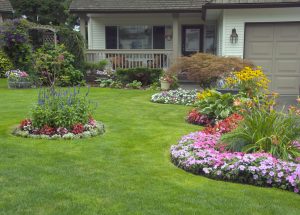Whether you’re a homeowner or manage commercial property, landscaping is important to the overall image of your home or business. You’ve probably invested time, money and effort into making it as close to ideal as possible. Then, one day, The Big One hits – and you’re left with toppled trees, a ripped up lawn, and flowers and shrubs that are utterly destroyed. However, don’t despair – a major storm can turn out to be a great opportunity to try out some new foliage, or to start over from scratch and test out a new design. If your residential or commercial property has recently been affected by a storm in New Jersey, take a look at these five ways to revamp your landscaping and make it better than ever before.
 1. Make sure that you carry out cleanup and repair effectively.
1. Make sure that you carry out cleanup and repair effectively.
After a storm, there are many safety considerations, as well as objects and areas to clean, before you can start over with landscaping and design. When facing toppled trees, the best option is to get rid of them; trees whose roots have been left open to the air for an extended period of time will often be unable to survive. Even if they have not been exposed for very long, trying to replant the tree may cause a safety hazard when the next storm comes, as the roots will be weaker than they were initially.
Make sure that all exposed roots are covered, usually by a burlap sack. Start by cutting the tree, leaving a lengthy stump; you can then pull out the stump, which is normally easier than digging it out. After taking care of fallen trees, make sure to clean up scattered leaves and branches, and replace any torn up lawn with new grass, as this will form the basis of your revamped landscaping.
2. Add some new accessories.
When giving your property a new look, you have an opportunity to add in objects such as fountains, sculptures, rocks and boulders, fire pits or lawn furniture that you never got around to adding before. With a more bare lawn, you have more freedom of design; you can then arrange your updated foliage around a new centerpiece such as a fountain.
Try to choose an accessory that will match the tone of your home or commercial property, in both color and style. This adds a unique touch to your property and makes it look more beautiful.
3. Try out some new trees.
With your old trees uprooted, you have the opportunity to test out different varieties; you can mix and match to find your favorites, doing your best to make sure the trees fit in with the overall look you are planning to portray. Evergreens, such as Italian Cypress or Magnolia trees, are a great option if you are looking for trees to provide privacy or for larger homes. Shade trees, such as poplars or willows, are also great options if you are going for a less austere look for your landscaping. You can also opt for flowering trees; for example, the flowering dogwood is a tree native to New Jersey that produces beautiful white blossoms every year.
No matter which trees you choose, remember to keep them at a far enough distance from your main building so that when the next storm comes, you don’t need to worry about any damage to your home or property.
4. Replace your old flowers and shrubs.
As with trees, if your flowers and shrubs have been completely devastated by the storm, you can try adding in new varieties to complement your home, any objects such as fountains or statues, and any trees that you have planted.
When planting flowers, you have a choice between annuals and perennials; annuals, which will flower and die each year, require much more maintenance, but can include such varieties as marigolds and petunias, which add bright splashes of color to your landscaping. Perennials include the common violet, the state flower of New Jersey; this plant will survive from year, and adds some thick foliage to your undergrowth.
5. If you give up and decide to start over, try out a new design.
At times, the damage may be so extensive that you simply don’t feel there is any way to salvage what you had before. In these cases, you have the opportunity to try out a completely new design for your landscaping; you can replace a simple lawn with a visually appealing garden landscape, or completely rearrange any pathways, garden areas, or accessories that were previously present.
When you opt to try out a new design, make sure that you spend some time developing the concept. You can also choose whether you want to attempt the project as a DIY or take on a landscaping service. You should also decide what kind of overall tone you want your landscaping to have, from exotic to sophisticated to cozy, and communicate this to your landscape design professional.
Thank you for reading our blog! How can we help you? Contact us today.




